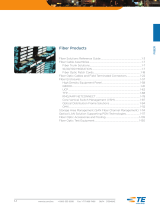Page is loading ...

®
1
Coupler Kit (7957)
For Standard 4-Conductor
Cables
(7876-XXX)
The Coupler Kit (included with Standard 4-Conductor Cables) is used to connect the
extension cables to the sensor cables. It includes a cable coupler and waterproof crimp-
style splice connectors for making the connection as well as a protective shell in which
you may place the connection point.
Components
The Coupler Kit includes the following components. Please make sure you have all listed
components before continuing.
• Protective Shell (in two pieces)
• Cable Coupler
• 4 Screws, #4 x ½” (12.5 mm)
• 5 Splice Connectors
• 1 Cable Tie
Tools and Materials Needed
• Small Screwdriver
• Pliers
• Telephone Wire Stripper or Knife
• Hose Clamps or Conduit Clamps
• Cable Clips or Weather-Resistant Cable Ties

2
Tips On Making Connections
• If the connection between the cables will be located outside, we recommend that
you use the splice connectors rather than the coupler.
With the splice connectors, there is less chance of the cables separating and also
less chance of water reaching the connection. Use the cable coupler only if the con-
nection is located inside, protected from the effects of weather and other stresses.
Note: “Inside” means heated and dry. If the connection is in an attic or basement with-
out heat, use the splice connectors.
• Try to place the connection between cables inside a building, underneath an
eave, or in another location similarly shielded from rain.
• The protective shell must be well secured to avoid wind buffeting. Use hose
clamps for poles or conduit clamps for surface mount.
• When securing cables, place a cable clip or tie on each side of the protective shell
so the movement of the cables does not cause the connection to pull apart.
• It is a good practice to leave an extra length of cable near the connection point
in case future adjustments or repairs are necessary.
To Connect the Cables Using Splice Connectors
1. Cut the modular connector off the end of the cable.
2. Use a telephone wire stripper or a knife to strip away about 1½ (3.8 cm)
inches of the black shielding on the cable.
3. Repeat this procedure for the end of each cable you are connecting.
STRIP SHIELDING
Note: If you accidentally strip away any of the colored shielding on the individual wires, trim off
the wires and repeat step 2.
4. Take a wire from one of the cables and place it in one of the holes at the end of
a splice connector.
Make sure you push the wire all the way in. You can check this by looking through
the clear side of the splice connector.

3
5. Take the same colored wire from the other cable and place it in the other hole
at the end of the splice connector you used in step 2.
Make sure you push the wire all the way in. You can check this by looking through
the clear side of the splice connector.
CONNECTING WIRES USING SPLICE CONNECTOR
6. Use pliers to snap the yellow cap into place, securing the wires.
7. Repeat this procedure for each set of colored wires.
8. Use a cable tie to secure the two cables together as shown below.
Doing this provides a measure of strain relief which should prevent the wires from
pulling apart under normal conditions. Cut off the excess cable tie when it is secure.
PROVIDING STRAIN RELIEF

Coupler Kit; for use with Standard 4-Connector Cables Product Number 7957
07395.010 Rev. D, October 12, 2011
This product complies with the essential protection requirements of the EC EMC Directive
2004/108/EC.
© Davis Instruments Corp. 2011. All rights reserved. Information in this document subject
to change without notice. Davis Instruments Quality Management System is ISO 9001 cer-
tified.
3465 Diablo Avenue, Hayward, CA 94545-2778 U.S.A.
510-732-9229 • Fax: 510-732-9188
E-mail: [email protected] • www.davisnet.com
®
9. Gather the wires and splice
connectors neatly together
and enclose the in the two
halves of the protective
shell as shown below.
Use the #4 x ½” (12.5 mm)
screws to join the two
halves.
To Connect the Cables Using the Coupler
1. Place the cable plug at the end of one of the cables into one end of the coupler.
2. Place the cable plug at the
end of the other cable into the
other end of the coupler.
3. Enclose the connection in the
two halves of the protective
shell.
Use the #4 x ½” (12.5 mm)
screws to join the two halves.
/






